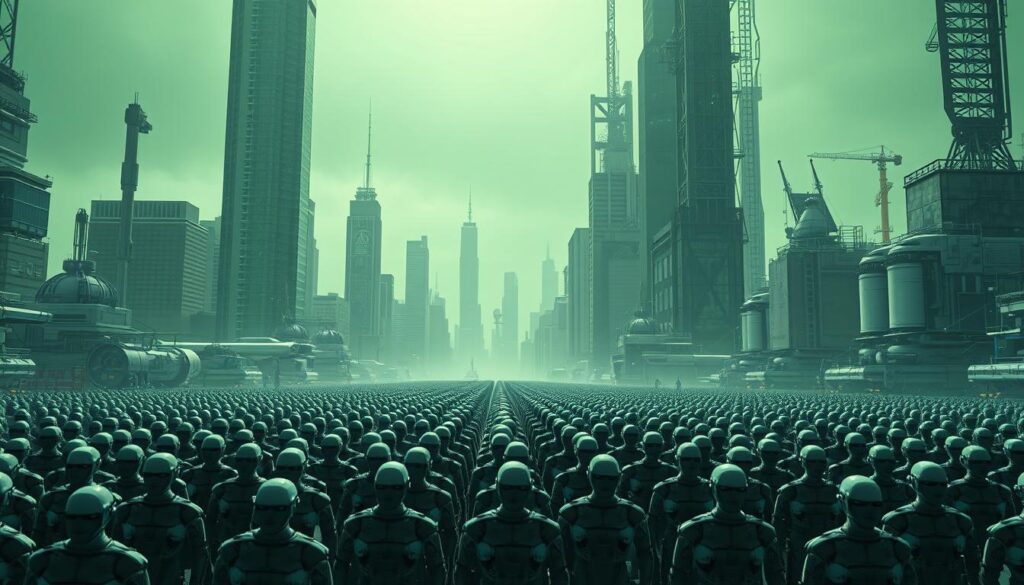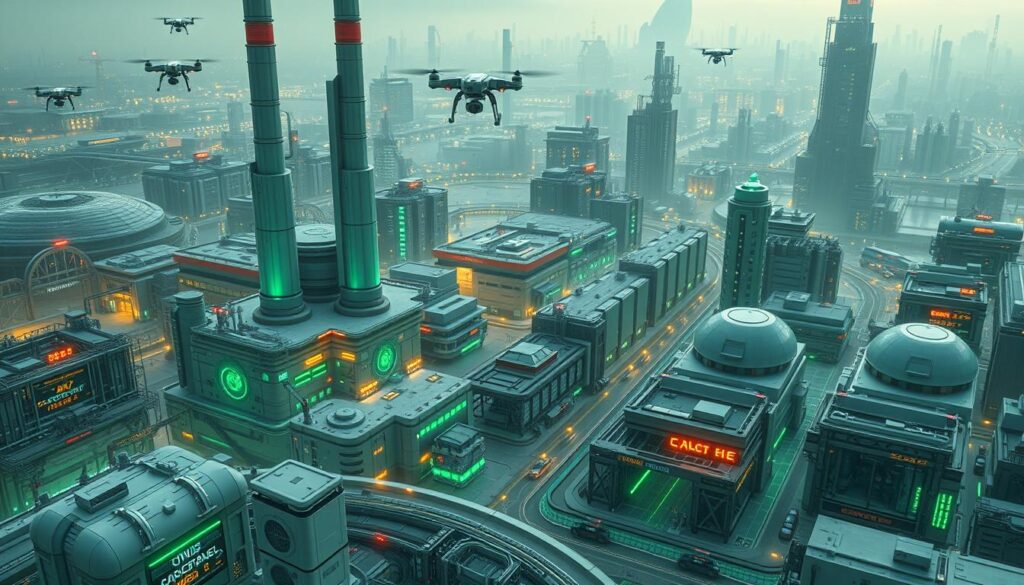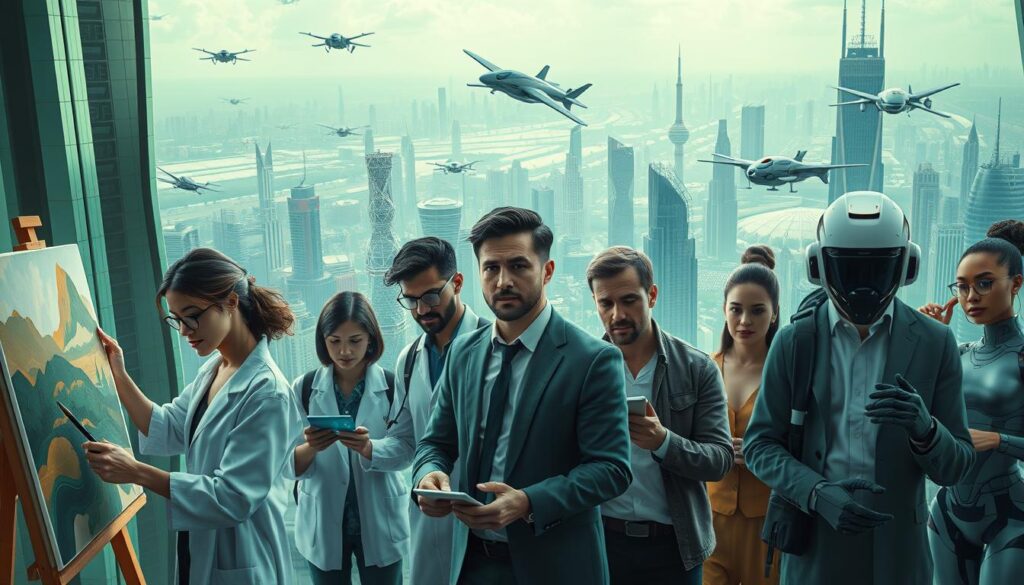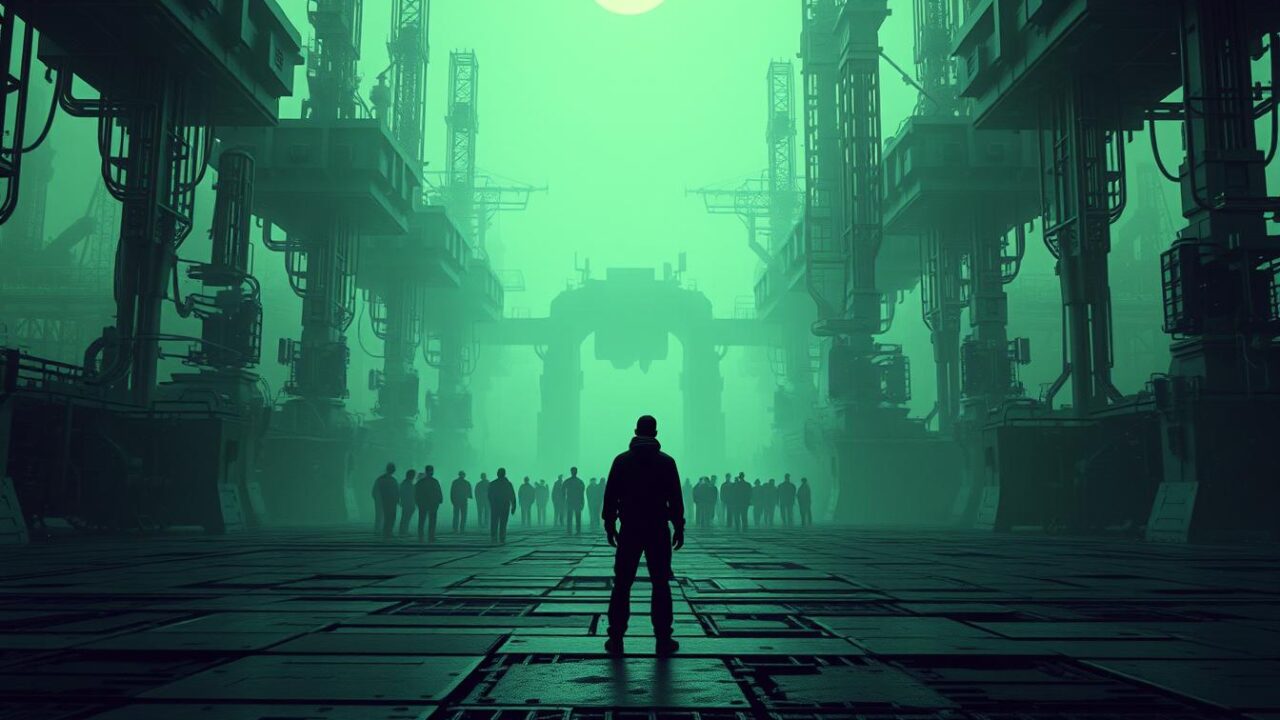By 2030, Pearson predicts a massive employment crisis. This crisis could see 85m jobs lost to AI. This number is more than Germany’s entire workforce, showing a big change in jobs and careers.
The United Nations Conference on Trade and Development says AI could hit 40% of global jobs. We’re seeing a big change, not just simple automation. The way we work is changing fast, but our education can’t keep up.
Companies spend billions on training, but the skills gap grows. Our job systems aren’t ready for an AI world that changes quickly. Tech leaders in Silicon Valley say job loss is inevitable, not just a possibility.
The gap between skills we have and skills needed grows every day. Old job paths are fading as AI changes industries. We have millions of jobs waiting, but unemployment keeps rising.
Key Takeaways
- 85 million jobs face replacement by AI technology before 2030
- 40% of global employment could experience significant disruption from artificial intelligence
- Skills mismatch creates empty positions despite rising unemployment concerns
- Education systems struggle to keep pace with rapidly evolving AI capabilities
- The future of work demands entirely new approaches to career planning
- Billions spent on training fail to bridge the growing skills gap
The Scale of AI Disruption: Understanding the 85m jobs replaced by AI ?

Artificial intelligence is changing the global workforce fast. The World Economic Forum says AI will replace about 85 million. This is just the start of a big change that will change how we work and what skills are important.
McKinsey’s Analysis: From Automation to Workforce Transformation
McKinsey and Company found that AI’s impact goes beyond just replacing jobs. They say many jobs will change a lot in the next five years. How fast jobs change depends on how quickly companies use new AI technologies.
Some groups, like women, might face more job loss risks. A UN report found jobs usually held by women are at high risk. This raises big questions about fairness in the job market.
The Timeline: When Will These Changes Materialise?
The time when jobs will change a lot varies by industry. PwC thinks up to 30% of jobs could be automated by the mid-2030s. The changes will happen in stages:
- 2025-2027: First, AI will change simple tasks
- 2028-2030: Then, jobs that need analysis will start to change
- 2030-2035: AI will get into jobs that need complex decisions
Global Variations: How Different Countries Face the AI Challenge
Every country faces its own AI challenges. Countries with lots of service jobs might change fast. But countries with lots of manufacturing jobs might change slower. The way education and technology differ around the world also affects how AI is used.
Industries at the Frontline of Automation

Some sectors are changing fast with machine learning. These areas are at the forefront of job changes. Automated systems are now doing tasks that people used to do.
Manufacturing and Warehouse Operations
Robotics and AI are changing production and storage. Automated lines work faster and more accurately than people. Smart warehouses use AI to manage stock better, cutting down on manual work.
Customer Service and Administrative Roles
Geoffrey Hinton, known as the “Godfather of AI,” says AI will replace mundane intellectual labour. He warns that jobs like paralegals and call centre workers are at risk. Chatbots are getting better at answering customer questions.
Financial Services and Data Processing
Banks are leading in AI use. Morgan Stanley cut 2,000 jobs in March, planning to use AI for some roles. Bloomberg thinks 200,000 jobs could go in five years at big banks like Citigroup and JPMorgan.
Transportation and Logistics
Self-driving tech is a big threat to driving jobs. Cars and trucks use AI for directions and finding the best routes. Drones are being tested for deliveries, which could mean fewer jobs for couriers.
The Human Skills That AI Cannot Replicate

Artificial intelligence is changing the workplace, but some human skills are still unique. Geoffrey Hinton, known as the “Godfather of AI,” believes physical skills will always be human. He says jobs like plumbing are safe because AI can’t handle the physical tasks.
The future of work will be about working with AI, not replacing humans. Instead of ten people, we might see one person working with an AI assistant. This means workers need to learn skills that work well with AI, not against it.
Key human advantages include:
- Physical dexterity in unpredictable environments
- Emotional intelligence and genuine empathy
- Creative problem-solving in novel situations
- Ethical judgement and moral reasoning
- Complex communication requiring cultural understanding
Hinton says AI won’t automatically create new jobs for those who lose their current ones. He believes only highly skilled people with skills AI can’t match will keep their jobs. This shows how vital it is to focus on uniquely human skills.
Jobs that need manual skills, like blue-collar trades, and roles that require compassion, like in healthcare, are safe from AI. These areas value human traits that are still crucial, even with new technology.
New Opportunities Emerging from AI Adoption
The idea of 85m jobs replaced by AI might worry some. But history shows that technology brings more chances than it takes away. The impact of AI on work is not just about losing jobs. It’s also about creating new ones that we never thought of before.
The Rise of AI-Specific Roles
Goldman Sachs’ 2023 study found that most jobs will see some automation. This means jobs will get better, not worse. New roles are popping up, like:
- AI trainers who teach machines to understand human behaviour
- Prompt engineers designing optimal AI interactions
- AI ethicists ensuring responsible technology deployment
- Machine learning operations specialists maintaining AI systems
Healthcare and STEM Professions in High Demand
The healthcare sector is very hard to automate. Nurses, doctors, and therapists need both technical skills and empathy. These are things AI can’t do. STEM fields are also booming, with data scientists and biotechnology researchers leading the way with AI.
Creative and Strategic Positions
Creative industries are doing well with AI around. Marketing strategists, content creators, and brand consultants use AI to improve their work. Economist David Autor’s research shows that 60% of today’s jobs didn’t exist in 1940. This shows that new jobs keep coming as technology advances.
Workforce Transitions: Preparing for the Shift
AI technology is changing fast, and everyone needs to act quickly. Workers, companies, and governments must work together. Pearson’s study shows we must close the learning gap fast, or millions will be left out.
Upskilling and Reskilling Initiatives
Companies spend billions on training, but the skills gap grows. A study says over 90% of organisations will face an AI skills crisis soon. This could cost the global economy £4.4 trillion. To succeed, we need:
- Learning platforms that keep up with new tech
- Hands-on training in AI tools
- Skills that mix technical and soft abilities
The Role of Governments and Educational Institutions
Educational systems need a big change to deal with job displacement. Schools and universities must move from old curricula to new, tech-focused ones. Governments should fund these changes and help workers reskill.
Corporate Training Programmes
Some companies are leading the way in training. Amazon’s Career Choice and Google’s Professional Certificates show how. They help employees move to new roles in an AI world, keeping them valuable.
Economic Implications of Mass Job Displacement
The impact of artificial intelligence on jobs is huge. It’s changing how we work and think about jobs. This change is big and affects many people.
SignalFire’s data shows how AI is changing jobs. Big tech companies are hiring fewer new graduates:
- Meta and Google cut graduate hiring by 25% between 2023 and 2024
- Entry-level positions at these firms now represent just 7% of total recruitment
- Traditional pathways from university to stable employment are rapidly vanishing
With 85m jobs at risk, the economy faces big challenges. Young people find fewer job chances. Mid-career workers must keep learning new skills. This change is not just about jobs; it’s about how we value work.
“The speed of technological change means traditional career planning has become obsolete. Workers must now think in terms of continuous adaptation rather than linear progression.”
These changes impact many areas, like how we spend money and pension plans. As AI grows, we must rethink income gaps, safety nets, and what work means. These are big changes we never thought we’d face.
Who Remains Safe in the AI Revolution?
Machine learning is changing industries fast, but some jobs are safe from automation. These jobs need skills like physical dexterity, emotional smarts, or solving complex problems. Knowing which jobs are safe helps workers plan for the future.
Healthcare Professionals and Human-Centred Roles
Healthcare is a safe haven from AI. Nurses, doctors, and therapists use their skills and human compassion to help others. They do things like surgery and counselling, which AI can’t do.
Social workers, teachers, and childcare providers also need both knowledge and empathy. They deal with unpredictable human behaviour every day. They make quick decisions based on the situation, something AI finds hard to do.
Skilled Trades and Manual Professions
Geoffrey Hinton, a leading AI researcher, says plumbing is a safe job. Electricians, carpenters, and mechanics face different challenges every day. Their work needs:
- Physical skill in tight spaces
- Thinking on their feet for new problems
- Talking to customers and building trust
Leadership and Complex Decision-Making Positions
Executive roles need strategic thinking. They involve weighing many factors like market trends and company culture. These jobs require making tough decisions where AI is not much help. Creative directors, business strategists, and innovation managers use both logic and instinct, a uniquely human skill.
Strategies for Career Resilience in an AI-Driven World
The workplace is changing fast with automation. It’s more important than ever to be career resilient. The future of work needs us to keep learning and use our unique human skills.
AI is now in places we didn’t expect. Self-checkout systems at Tesco and ASDA are just the start. Soon, AI will handle emails, marketing, and even finding new talent. This means we need to plan our careers carefully.
To do well in a world where jobs might change, we should learn new skills. Here are some key strategies:
- Master complex problem-solving that requires emotional intelligence
- Develop creative thinking abilities that go beyond pattern recognition
- Build strong interpersonal skills for roles requiring human connection
- Cultivate adaptability to navigate changing technological landscapes
- Pursue continuous learning through platforms like Coursera or LinkedIn Learning
The best workers will see AI as a partner, not a foe. By learning skills that make AI better, like making ethical choices and planning, we become vital in the future.
To succeed, we must be open to change, keep learning, and be flexible in our careers. The future of work is for those who adapt now.
Conclusion
The arrival of artificial intelligence in our workplaces is a major turning point in economic history. It’s expected that 85m jobs will be replaced by AI in the next few years. This change is both a challenge and an opportunity.
This transformation is as big as past industrial revolutions. But it’s happening faster and on a bigger scale. Everyone – workers, businesses, and policymakers – needs to pay close attention.
Technological unemployment doesn’t have to be a disaster. History shows that automation has always led to new job creation. The printing press and the assembly line are examples of this.
Today’s AI revolution is following the same path. It’s creating new jobs we can’t even imagine yet. But it’s also ending jobs we know well.
To move forward, we need to take action, not just accept things as they are. Workers should keep learning and focus on skills AI can’t replace. Companies should invest in training their staff for the future.
Education systems and governments must also change. They need to prepare people for a world where AI is common. This way, we can all adapt to the new job landscape.
Success in the AI age depends on being proactive. We need to understand which jobs are at risk and which are safe. By doing this, we can find our place in the new world of work.
The future workplace will be different, but humans will still have a vital role. It’s about finding where our creativity, empathy, and problem-solving skills are needed most.
Want to hire me as a Consultant? Head to Channel as a Service and book a meeting.

